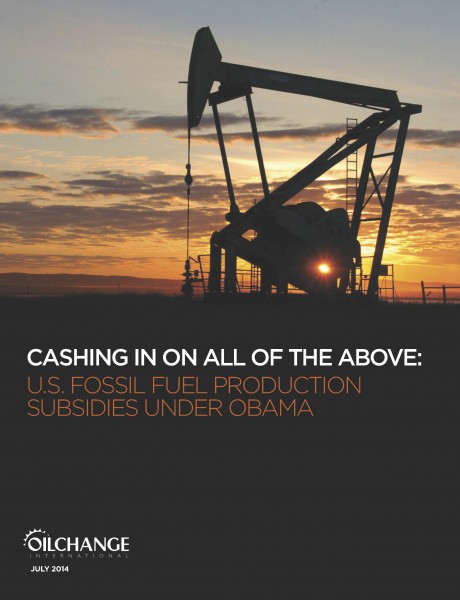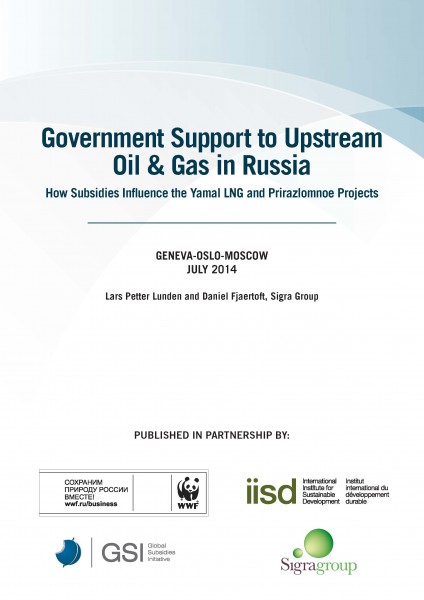Two important publications on fossil fuel subsidies were released last week, though covering quite different aspects of the problem. The first, by Oil Change International in Washington, DC, updated information on US subsidies to fossil fuels to 2013. Their work captures the subsidy escalation that has occurred following surging domestic production of oil and gas in recent years. The second, produced for the Global Subsidies Initiative in Geneva and WWF Russia, provides two case studies of Russian gas projects in the Arctic Circle. This is an environmentally sensitive region of the world that, ironically, is facing greatly increased pressure for hydrocarbon extraction as the climate warms.
 Cashing in on All of the Above:
Cashing in on All of the Above:
U.S. Fossil Fuel Production Subsidies Under Obama
by Shakuntala Makhijani (Oil Change International)
Report Highlights
- Growth in domestic production has resulted in sharp (up 45% since 2009) growth in federal subsidies to oil and gas as well.
- Subsidies to fossil fuel exploration and production in 2013 were $21.6 billion. Of this, state-level subsidies comprised $3.1 billion -- though not every state has been analyzed yet.
- Subsidies to fossil fuel consumption exceeded $11.2 billion for 2013, of which $2.2 billion was at the state level.
- The study provides an updated literature review of subsidy values related to oil defense and fossil fuel-related externalities, though does not include these large values in its reported totals.
- A tally of fossil-fuel-related project finance through US export credit agencies (ECAs) also highlights that even in a world of increased concern over global warming, the ECAs continue to provide subsidized credit and insurance to the fossil fuel sector.

Government Support to Upstream Oil & Gas in Russia:
How Subsidies Influence the Yamal LNG and Prirazlomnoe Projects
by Lars Petter Lunden and Daniel Fjaertoft
I wrote about the rush to develop Arctic oil and gas reserves back in October 2012 (Russian Yamal Peninsula LNG Project: Tracking subsidies to Arctic destruction), and unfortunately the situation does not seem to have improved in the years since.
Not surprisingly, I was delighted when the Global Subsidies Initiative, in conjunction with WWF Russia, decided to fund some detailed work on the issue -- including the Yamal LNG project. Their analysis is a first step in calling attention to some very complicated market dynamics associated with government-led regional development of natural resources in environmentally-sensitive regions.
For these types of projects, individual subsidy line items are but a starting point. It is vitally important as well to look at the broad set of policies, including less direct ones such as roadbuilding or transport links, and assess the degree to they shift so many of the development risks from the private to the public sector that they "tame" the high risk regions for profitable development. This shift is relevant not only for this project, but for many others that follow. It is the full number of projects, after all, that convert pristine ecosystems into industrial waste lands.
Often, this "taming" actually requires enormous public financial support per benefit created -- though the costs are masked, hidden, and shifted in all sorts of clever ways. When this dynamic of public intervention occurs in areas of poverty or urban blight, we normally applaud the efforts as necessary and important development that are critical to "turn an area around." When the behavior occurs in environmentally sensitive regions such as the Arctic, the trade-offs and reactions are (indeed, must be) quite different.
Even if there are poverty-elements to these regional support strategies (as there often are with developing world mining projects, for example), the risk shifting remains problematic. The environmental damage is often irreversible, and the selection of a natural resource-intensive pathway can represent a false choice. Quite often there are multiple development path options for job creation or regional improvement -- some of which can offer similar social gains at a much lower environmental cost.
Report Highlights
- Viability dependent on government support. Both the Yamal and the Prirazlomnoe projects would not have been viable without some of the government support analyzed. This conclusion was reached even with some important gaps in the types of subsidies the research team was able to quantify. For example, they were not able to assess preferential credit terms for some important financing agreements, or evaluate the level to which insurance and indemnification requirements were adequate and privately funded. Inclusion of missing subsidies would have further worsened the returns.
The authors frame this issue as follows in relation to the Yamal project:
The Yamal LNG project seems marginal from an economical point of view, i.e., the project shows small positive economic returns pre-tax, and marginally negative economics pre-tax if the project would have to pay all infrastructure investments. By paying for a large share of infrastructure investments, the government has
granted the owners of Yamal LNG a considerable subsidy.
In the meantime, proponents of Yamal LNG would claim there are strategic reasons for developing this project. Yamal LNG will be Russia’s first LNG project for west and east-facing markets as well as Russia’s first non-Gazprom gas export project. Moreover, it will generate traffic for the Northern Sea Route and pay for and utilize icebreaker services. In addition, Yamal LNG will contribute to the development of the Arctic region,which some regard as a benefit per se (p. 34).
- Viability sensitive to discount rate assumptions; these may be even higher than assumed. The profitability of the projects is sensitive to which rate of return is assumed appropriate for investment in the projects.[fn]In the paper, the authors assumed a 10% real discount rate for the oil industry, with an additional 2% added to reflect country risk in Russia (page 8). However, the fields examined were not just in Russia, but in the Arctic -- so an even larger rate adjustment might be warranted.[/fn] It is notable (though not explicitly stated) that the appropriate rate of return is, in itself, influenced by the degree and type of government involvement with the projects.
- Pattern of regional support evaluated at a first level; further analysis would be quite useful. As noted above, a critical aspect of reviewing subsidies to “remote” resources (either geographically or technologically) is how a pattern of government support alters not only a single project, but the development trends in an entire regions. Canadian subsidies to the tar sands in Alberta is a good example of this; or US hydro dams and the expansion of agriculture in parts of the US West. To the extent that Russian infrastructure, services, and subsidies are not only supporting Yamal, but also derisking other investments in fossil fuel development in the Arctic that would previously have been unprofitable, the subsidies both reduce the breakeven rate of return needed for Yamal and Prirazlomnoe to go forward, and accelerate development of other fields in the area. The GSI/WWF paper, by looking at subsidies to infrastructure to the fields, opens debate on this critical issue. Much more research is needed.
- Tax breaks seem to lack an underlying strategy. Tax breaks to the oil and gas developments evaluated seemed to be granted ad hoc, in some cases apparently to bolster demand at military shipyards, rather than per an underlying set of rules. This approach normally increases the latitude for more political deals.
- Employment gains do not look large. Job creation and development benefits to the local population appears to be fairly limited, given their existing skills and industries, and substantial tenders already underway to foreign firms.
- Environmental risks inadequately assessed. The returns on the projects (even with subsidies) remain moderate, and environmental damages from dredging, spills, or other activities would likely turn those negative. The authors note that the environmental reviews conducted thus far do not appear to be robust, and that independent reviews anticipate significantly larger environmental risks than have been reflected in the official documents.